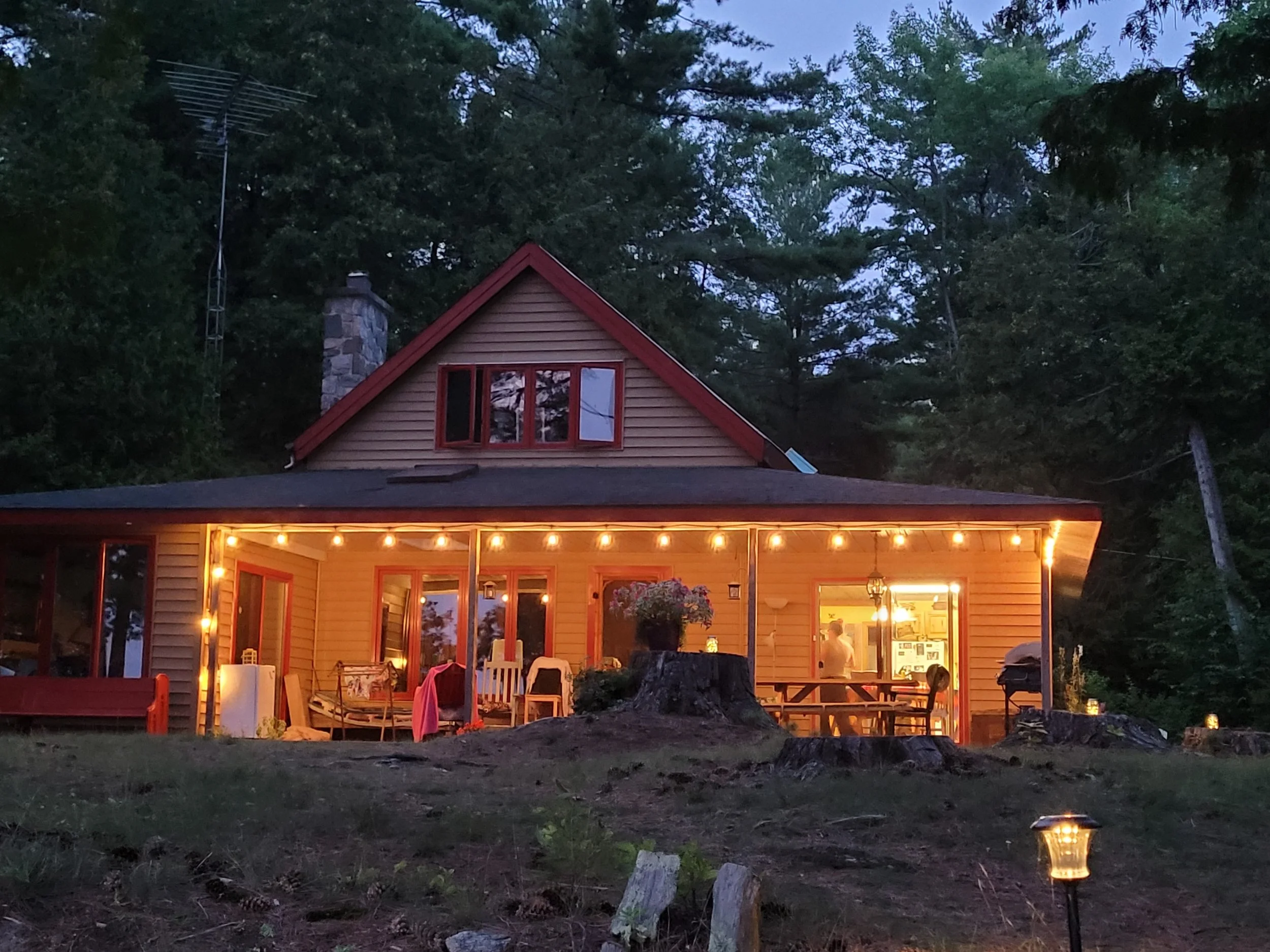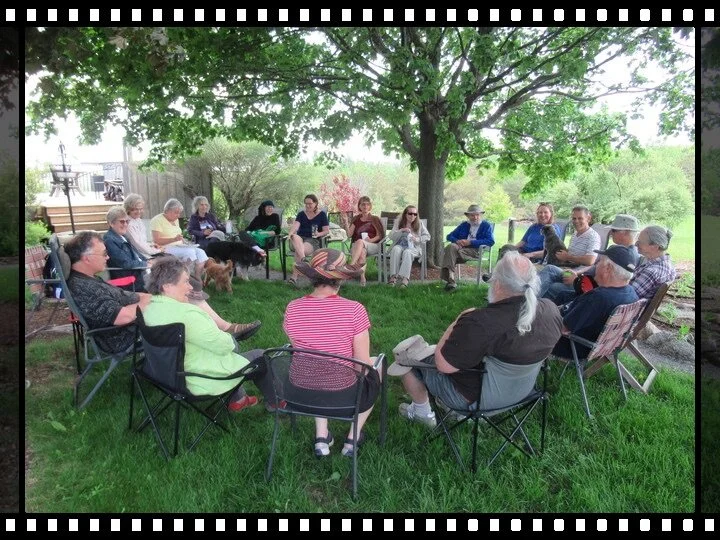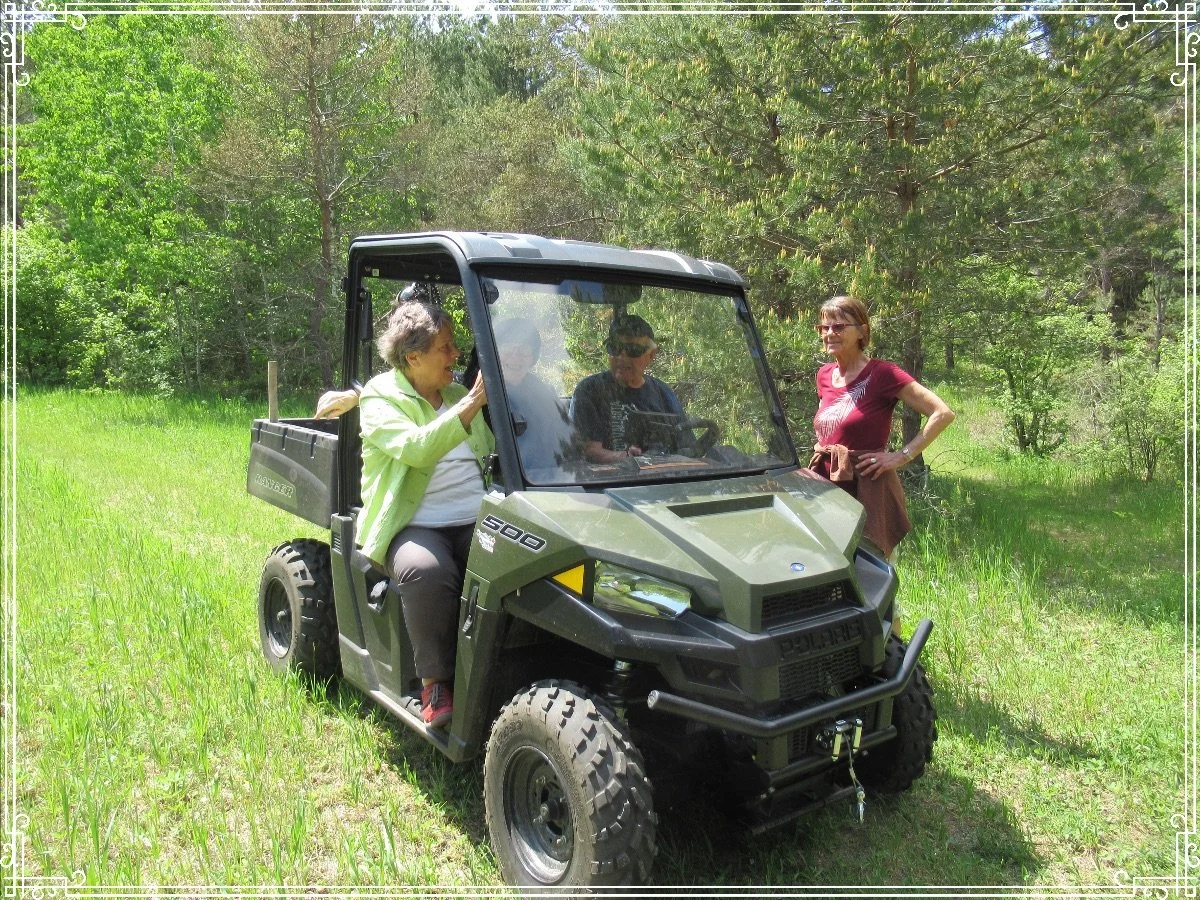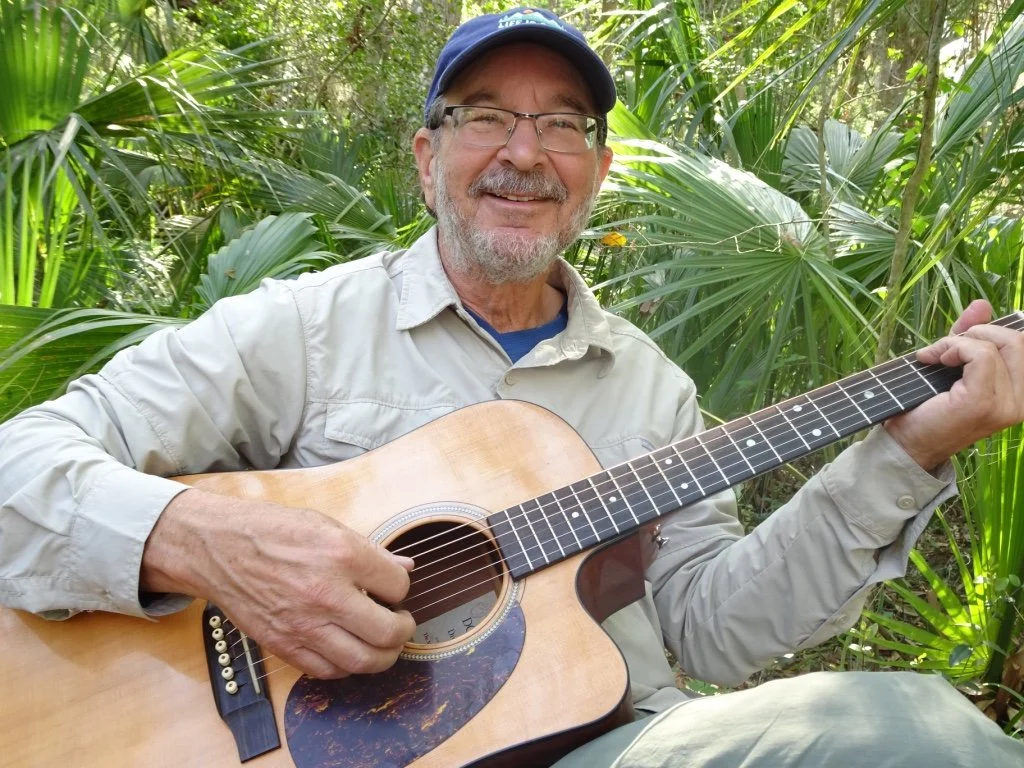The Summer Edition
Note: The newsletter is going on its annual summer holiday. Look for our next issue in September. Have a good summer!
The Cottage, by Mathew Ingram
Some of my earliest memories are of summers at our family cottage on Golden Lake in the Ottawa Valley -- paddling around in an old wooden sailboat/dinghy with my two older brothers, swimming around looking at the golden sparkles in the sand (iron pyrite or "fool's gold", which gave the lake its name) or, when I got older, paddling in the canoe and driving our old aluminum boat with the nine-and-a-half Johnson motor. It's a relatively small lake -- really just a wide spot in the Bonnechere River, about 10 kms from one end to the other -- which means it is very quiet, just the way I like it :-)
Our family moved around a lot when I was growing up, because my father was a pilot in the Air Force -- we moved about a dozen times in 17 years -- so the cottage was like our permanent home. Every June, my mother would pack us in the car and we would spend the whole summer at the lake, swimming and playing hide-and-seek with neighbour kids, going into town for ice cream at the local motel, and then later on getting into trouble by driving around the back-country dirt roads at high speed with our friends. And our three daughters have had similar kinds of fun -- although hide-and-seek isn't as popular, the ice cream place moved because the motel shut down, and we didn't let them drive the back roads at high speed with their friends :-)
My mother had some of the same kinds of memories from when she was a little girl, because the cottage was bought by her grandparents -- Percy and Verona -- sometime in the 1920s. It was originally just a one-room shack, built by an engineer who worked one of the regional railways that went past the lake. There's a date -- 1910 -- written on one of the roof beams in grease pencil, and I've always assumed that was when it was originally built. The beam, like the rest of the cottage, is made out of hemlock, and the floorboards are amazingly wide; 18 inches, something you could never find in a modern lumber store.
My grandmother added a second story, and a fieldstone fireplace, and a verandah that went around two sides, for sitting in rocking chairs or playing ping-pong. And she added three sleeping cabins, which were originally just platforms with posts and a roof, and canvas walls that would roll down in the evening. Later they became cabins, with walls, but they are still very rustic, with just bare wood and screens in the windows, and wooden shutters that lower when there are storms or for the winter. Becky and I sleep in one until the temperature drops down below zero in the fall, when we usually wimp out and move into the main building.
When I was young, we had to get water from a well that looked exactly like the one in the tale of Jack and Jill, with a little peaked roof and a round foundation made of rocks. Since there was no plumbing, we also had to use the outhouse, which was the height of luxury -- it had two seats! We got running water around when I was 18, and we were all very grateful. (Though I sometimes still go to the outhouse just for old times' sake.) Now we even have a television and all kinds of modern conveniences we didn't have when I was growing up. One thing I kind of miss is the telephone "party line," which we shared with the ancient Luloff sisters who ran the farm down the road. You could always hear a click when they picked up the line to listen in, so they could share all the gossip in town later.
The cottage is surrounded by giant pine trees that are probably 150 years old or so, which has made life occasionally very interesting -- like when the big one to the east fell and wiped out the entire side verandah. That's when my father decided to put in a more modern kitchen. Then another one took out part of one cabin, which we repaired. And, not that long ago, another huge one in the front crushed most of the kitchen wall, including the table where my mother usually sat (she was in Mexico, thankfully). Luckily, our insurance paid for a new roof, new siding and a new front porch.
Apart from that sort of thing, life at the cottage has been blissfully slow and uneventful (knock on wood). We sit on the beach in the sun, paddle around in kayaks, have dinner at the picnic table on the front verandah, and then go for sunset cruises on our pontoon boat -- which I like to call the "floating living room". The idea is to go as slow as possible, and sip your wine or coffee or whatever, and just enjoy the view. It's paradise, and I hope it stays in our family for another three generations.
Food & Forest Bathing by Lyn Miller
On Sunday May 29th, a group of 19 KCCers enjoyed a delightful social gathering at Jean and Ralph's beautiful Pontypool home. Only a few of us got slightly lost getting there 🙂. We were fortunate to have great weather for our potluck lunch on the deck and lots of conversation, laughs and story-telling took place. Thank you to everyone for the many yummy culinary contributions - we feasted well. Our visit was enhanced by the three well-behaved dogs also in attendance.
After lunch, we were entertained and enlightened as Ralph told us about the history of their property including the building of their house and the later relationship with the Kawartha Land Trust. We learned about the work that has been done and continues to be done to manage the forest, protect the wetland, establish the tall grass prairie, control invasive species and maintain the trails. This land is a true gift to all, now, and into the future.
Fruited Quinoa Salad by Judy Amsbury
1 cup quinoa (or substitute couscous)
1 ½ cup boiling water
Simmer about 15 min. covered until all water is absorbed. Cool.
Add and mix:
1 small English cucumber, diced (about 2 cups)
1 cup green onion, chopped
¼ cup raisins
¼ cup diced dried apricots
¼ cup dried cranberries
1 small tin whole mandarin orange, drained
¼ cup toasted pecan pieces or sunflower seeds
Mix together:
2 tsp fresh lime zest
¼ cup lime juice
2 Tbsp sesame oil
1 tsp white sugar
¼ tsp each ground cumin and coriander
Toss well with quinoa and fruit/veg/nuts. Refrigerate 1 hour minimum. 8 servings.
Equity Member Interview – Arthur Herold
You can take the boy out of the 60’s, but you can’t take the 60’s out of the boy. Arthur is our very own (ex)hippie. He has some great stories, which I can’t include here, but which you should ask him about sometime – you won’t be disappointed!
Arthur was born in Shreveport, Louisiana. What was it like there? It is north Louisiana, which is more akin to being in Mississippi or Arkansas. South Louisiana is a different culture, somewhat informed by the Acadians (Cajuns) who were transplanted there. North Louisiana is a Scots/Irish redneck kind of area. Why doesn’t he have a southern accent? He lost it in university; but he can use it when he wants to (which he demonstrated).
Arthur is from a Jewish family. His father was a doctor. His mother was manic/depressive; when he was born, she had a psychotic break. She was a nice person who was in the hospital a fair amount; “she was pretty nutty when she was manic.” Dad was a nice fellow too, very involved with his work, and a Conservative southern gentleman. Arthur has a sister 2 years younger. Both of them were raised by the family’s black maid and they got a lot of good mentoring from her. Arthur had a very happy childhood; his mother described him as a very pleasant child; happy-go-lucky. He had a good group of friends. He could ride his bike all over town, he liked to fish and be outdoors. He was part of a boy scout troop that camped a lot.
He graduated high school in 1964. He was part of the change in culture at the time and got involved in left wing politics. This was hard for his traditional father to understand, so there was some friction there, but they always had affection for each other. Arthur went to university at Louisiana State for 2 years doing pre-med. He took some courses in English and Philosophy, which he found much more interesting and switched schools – he graduated from the University of Texas with a Philosophy degree. How did Dad feel about that? He may not have been pleased, but he never pressured Arthur, who was a good student with good grades and Dad was proud of that.
Arthur became a hippie and started taking drugs – psychedelics, which were fantastic. Obviously, he didn’t jump off any cliffs (some people did), but he had a lot of religious experiences, which he was predisposed to. It’s hard to talk about those experiences, but they were wonderful. The drugs helped him in his emotional development; he was cerebral and emotionally detached, but on acid it was like a dam broke that had been holding his pent-up emotions, and it softened him up. He took acid and mescaline about 60 times and got in the habit of taking it once a week, on weekends.
The Viet Nam war was going on and he was lucky to get a conscientious objector designation. The whole process was notoriously unfair – the draft board in Shreveport knew his family and he got it as a result of his privilege. You had to do 2 years of social service work instead of going into the army. Arthur moved to New York City and worked in Manhattan for the Welfare Dept. He did 1 year there. His girlfriend had gone to the San Francisco Bay area and told him how great it was. He got a transfer out there and worked for the American Friends Service Committee (Quakers) in a half-way house for ex-convicts. When he finished with that, he got himself a backpack and sleeping bag and lived out of that for a while. He drove a school bus to survive.
He heard talks from Stephen Gaskin, the founder of The Farm, a commune in Tennessee of over 2000 acres. Arthur made his way out there in 1971 and lived there 5 years. All things were held in-common, they took vows of poverty and were vegetarian. He handed his VW bus to the motor pool and kept his clothing. He lived in the single men’s tent. There was a lot of hard work, trying to live on the land. He learned carpentry skills and was an amateur electrician. People were supposed to tell the truth all the time and to sort out problems. Some of the women became midwives to the community. He got married to a woman from Texas – it was a whirlwind romance; she got pregnant and they found they couldn’t stand each other after 3 months. This was a very dark chapter of his life because his ex-wife wouldn’t let him be a part of his child’s life. Now in adulthood, he has a relationship with his daughter who lives in Arizona.
Arthur met Linda at a party on The Farm. They got engaged. Since Linda was Canadian, eventually there were immigration issues, and they left with other “mixed” (American/Canadian) couples to live on a branch of The Farm in Canada near Lanark, north of Perth. They stayed 8 years. They had some fertility issues but, “by God, they produced one child”: their son Sam.
They left The Farm when he was 38 years old. Things were starting to unravel; there were personality conflicts and middle age hit and people were tired of the poverty and wanted to use this last chance to leave and have a life “off the Rez”. They moved to Toronto and Arthur tried to be a food entrepreneur, selling a frozen soy-based dessert. This was moderately successful for a while. They moved near Millbrook, Ontario where their parents helped them buy a little house on a country road. He got a job working as a Social Worker in Child Protection at the Children’s Aid in Cobourg, which he found to be a lose/lose proposition – the kids are at risk in the family and, once taken out, are at risk again. He decided he wanted to be a therapist and got a Masters in Counselling Psychology, and also became a Marriage and Family Therapist. He got a job in Peterborough at a non-profit counselling agency and worked there for 20 years. He was clinical manager for the last 7 of those years.
In 1992, they adopted a lovely infant girl from Guatemala. His son was 13 at the time, so they “raised two only children”. Their daughter just had her own baby girl this year. She lives in London, Ontario and they wish she were closer. Their son, who lives a few blocks from them, has 2 girls age 13 and 9.
Arthur and Linda belong to the Unitarian Fellowship and he is Chair of the Refugee Sponsorship Committee; Linda is co-chair of the Refugee Settlement team. They both play tennis. He enjoys music, fiction and poetry, and investing is a hobby; he manages Linda’s 98-year old mother’s finances, as well as their own. They love to camp and canoe and go to Florida every winter to state parks to swim, cycle, hike and play music.
Introducing… Erika Steinhubl
Spontaneous is the word that describes Erika best; if someone has an idea her answer is, “I’m in”. Sometimes she has to pull back the reins, but she is very keen on doing new things and exploring. Also, the number 2 seems to be very important in her life (see below).
Erika was born in Montreal in 1949. She grew up in NDG (Notre-Dame-de-Grâce or No-Damn-Good). She went to an English Catholic grade school and high school. Her parents were from a German area in Czechoslovakia and were from the same little mile-long village; her mother lived at one end, and her father the other. They never met until both moved to Montreal. They spoke German at home. She had one brother with whom she was pretty close, but he died in the 1990’s.
Erika went to McGill to study Psychology. She wanted to improve her French, so she rented a room from a French family. She wanted to understand how they felt their language and culture were being repressed. They, on the other hand, were not curious about anglophones. It also turned out they were FLQ. She only found out the day she moved out.
She was at McGill for 2 years, then went to the University of Bamberg in Germany, getting her ESL teaching certificate in 1 year. She went back to McGill and finished her BA in Psychology (2 more years). After this she got a job doing research in Agricultural Economics at UBC (!) The professor wanted someone with no prior knowledge of the subject. The research was in Vancouver and she hitchhiked her way there and worked for 2 years.
Erika got a job with CUSO for 2 years in Tonga as an ESL teacher. They all lived in little huts made of coconut fronds and she made her own hut with her students. It’s a Polynesian society, so it was matrilineal and matriarchal. This is where she first came into contact with living in community – in Tonga, it was taboo to eat alone; you had to share what you had to eat. Living there made her want to be a nurse; CUSO had given her a huge first aid kit and they had no health services, so people would come to her when they were hurt or sick.
She came back to Canada and went to NB for a year of nursing in a hospital school. She met her husband when she was home for Christmas. He was doing his PhD in Metallurgical Engineering at Queens in Kingston. When they got married and she moved to Kingston, she did a diploma nursing course for 1 more year at a community college.
They both decided to go to Peru with CUSO again. Erika worked as a nurse at a hospital in Huancayo. She learned to speak Spanish fluently. Her first child, a son, was born there in a home birth. They worked there for – guess what – 2 years and they came back to Kingston. She was pregnant again and wanted another home birth. Why? She just thought of birth as something normal; like doing laundry. Both babies came exactly on their due dates, and she had lots of energy after giving birth, so it was no problem for her.
Her husband was offered a job at Fleming College, so they moved to Peterborough. She was a stay-at-home mom until her daughter was about 5 years old and then she worked as a VON community nurse. She and her husband split up in 1991. She got her Masters in Counselling from Ottawa University; driving to Ottawa and back each week for the 5 courses, doing the practicums and working part time -- she somehow got through her courses and her thesis in 1 year! Her mother looked after the kids. She worked several part-time jobs so she could tweak her hours to be with the kids when it was her turn. When the kids were off to university, she became a full-time CCAC case manager in Lindsay for the next 15 years.
Erika started working in the Lindsay jail. What was that like? She learned a lot – she learned to be afraid of the police and the jail guards. Lindsay jail was a remand centre so prisoners were awaiting their time in court; the nurses worked under the assumption of innocence and the guards of guilt. The prisoners loved (but the guards hated) the nurses. She learned a lot about the legal system and that if you are dealing with the police to “only answer what is asked, never volunteer information”.
Around 2010 she started walking the Camino de Santiago in Spain. It took 6 years; she would go every two years, walking about 200 km until she did the whole 795 km. Spain made quite an impression on her – the culture; the people were very friendly with a lot of joie de vivre, and she loves the heat. In 2016 she rented an apartment in Barcelona for 2 months in the winter to practice for retirement.
In 2017, an old friend from Montreal asked Erika to take care of his ailing mother, who was living in San Diego (“paradise”). He knew she was retiring and had lived in San Diego before (for umm… 2 years). She did this for a year, also doing a continuing education unit, and moved into palliative care (which she worked in for – 2 – years). How was that? She thinks of it as akin to midwifery; helping people to move from this life to the next. People were very glad for the service and it was very affirming. Dying, in our society, is not talked about much and in that setting everybody did – it helped her to talk with others about growing old and dying.
In 2019 she retired, and moved back to Peterborough to take care of her 94-year old aunt, who died just before Covid. Both her children live in Peterborough. When Covid hit, she became a vaccinator. Many people came out of retirement to help and they all missed seeing clients, helping people and working in the community. It was so gratifying to do; there’s nothing better than having clients who are happy with what you are doing.
Erika enjoys doing some genealogy, reading (she is in the book club), cooking, gardening and walking. She is waiting to have knee surgery and hopes do more after that. She has an aspiration to live in Tuscany on a farm with a bunch of other people for a year.
She heard about cohousing in 2014 at one of Scott’s talks. Frances, an associate member, is living in her house and it made her think about growing older in place. She has lived on her own for about 30 years now so she’s looking forward to living in community. The people she has met at KCC are terrific! She hopes that her connection to the number 2 means that our cohousing project will be built 2 years after she joined (October 2021).
Wise words
You can’t use reason to convince anyone out of an argument
that they didn’t use reason to get into.
-Neil deGrasse Tyson







